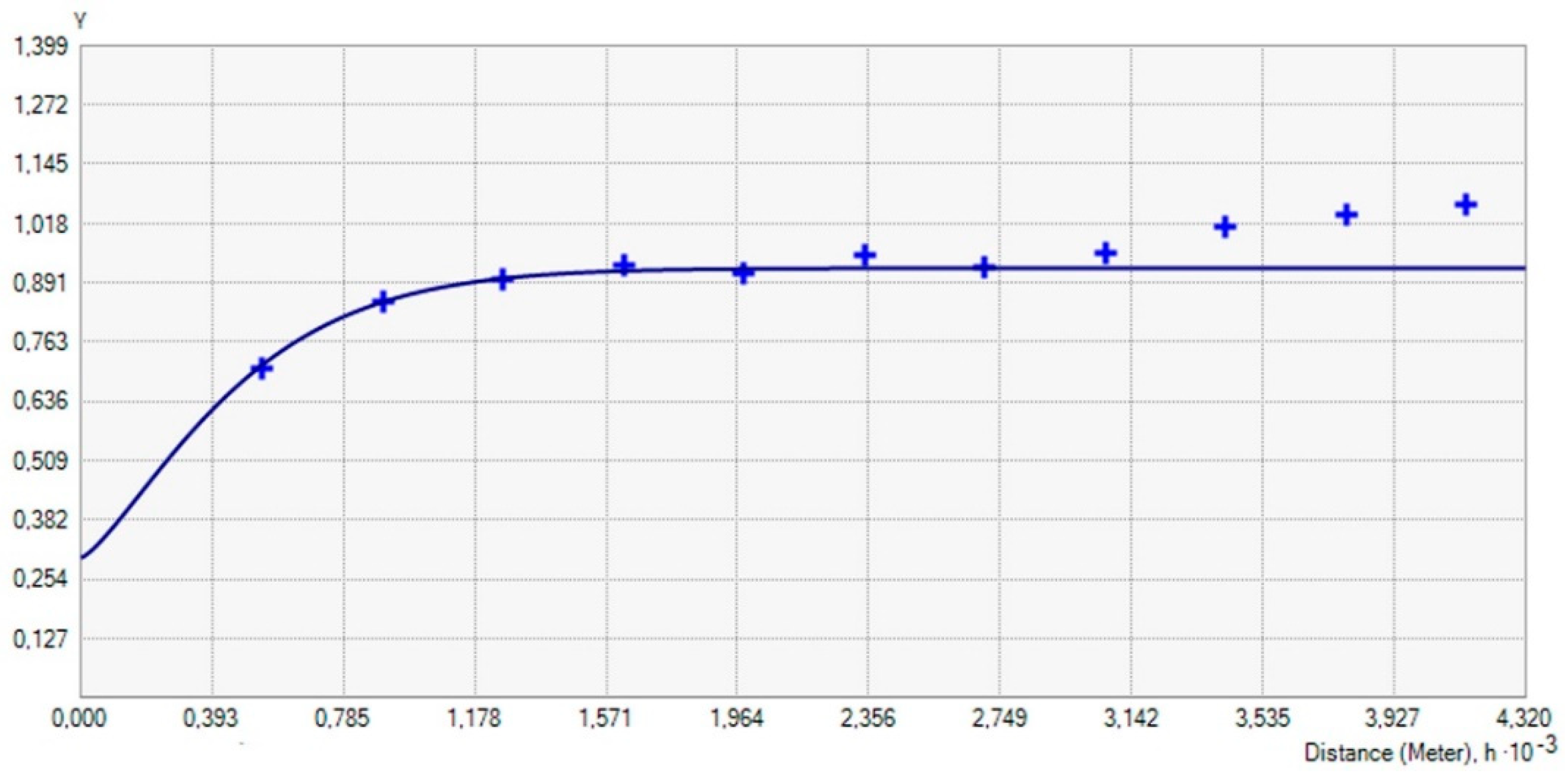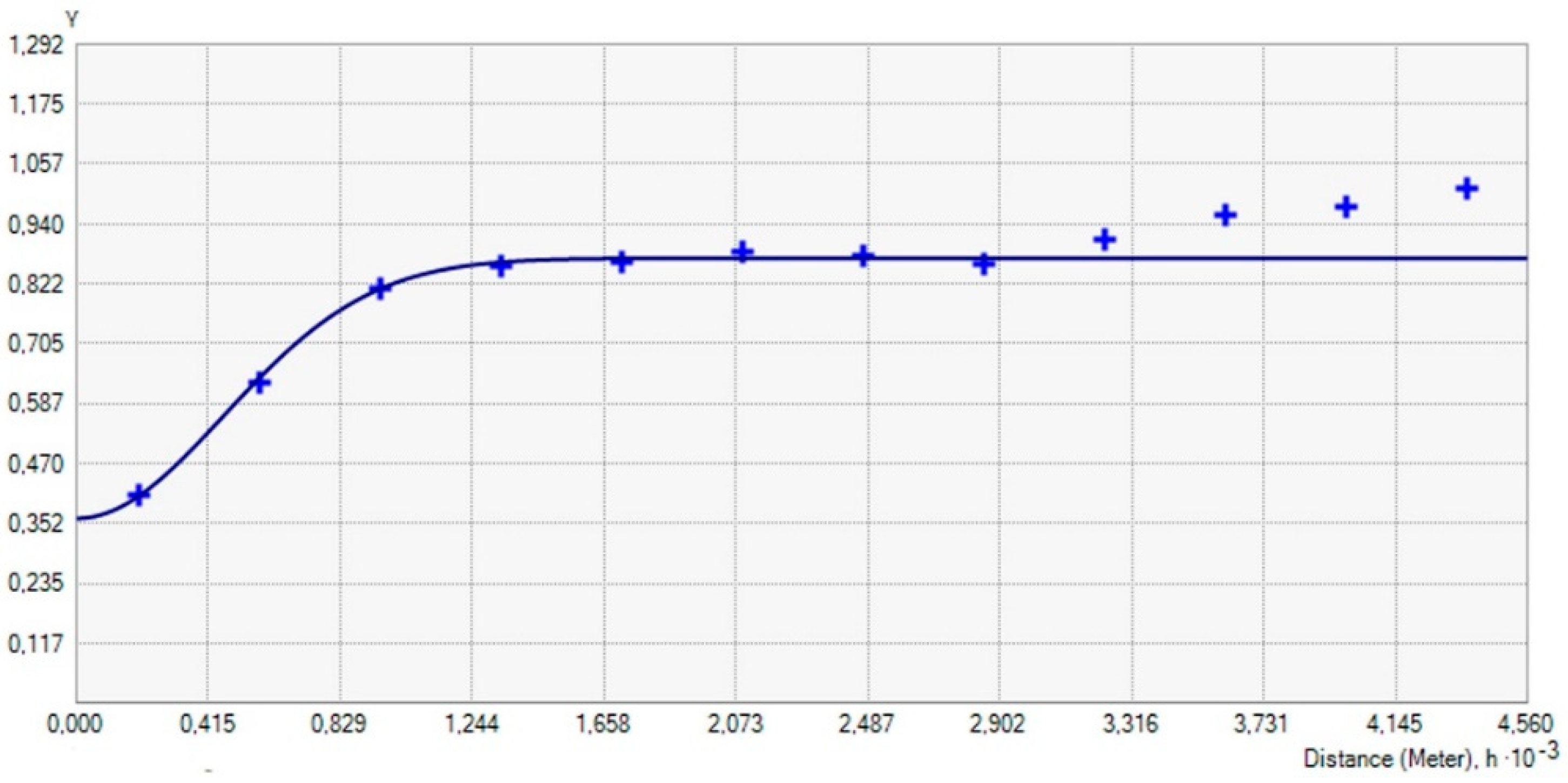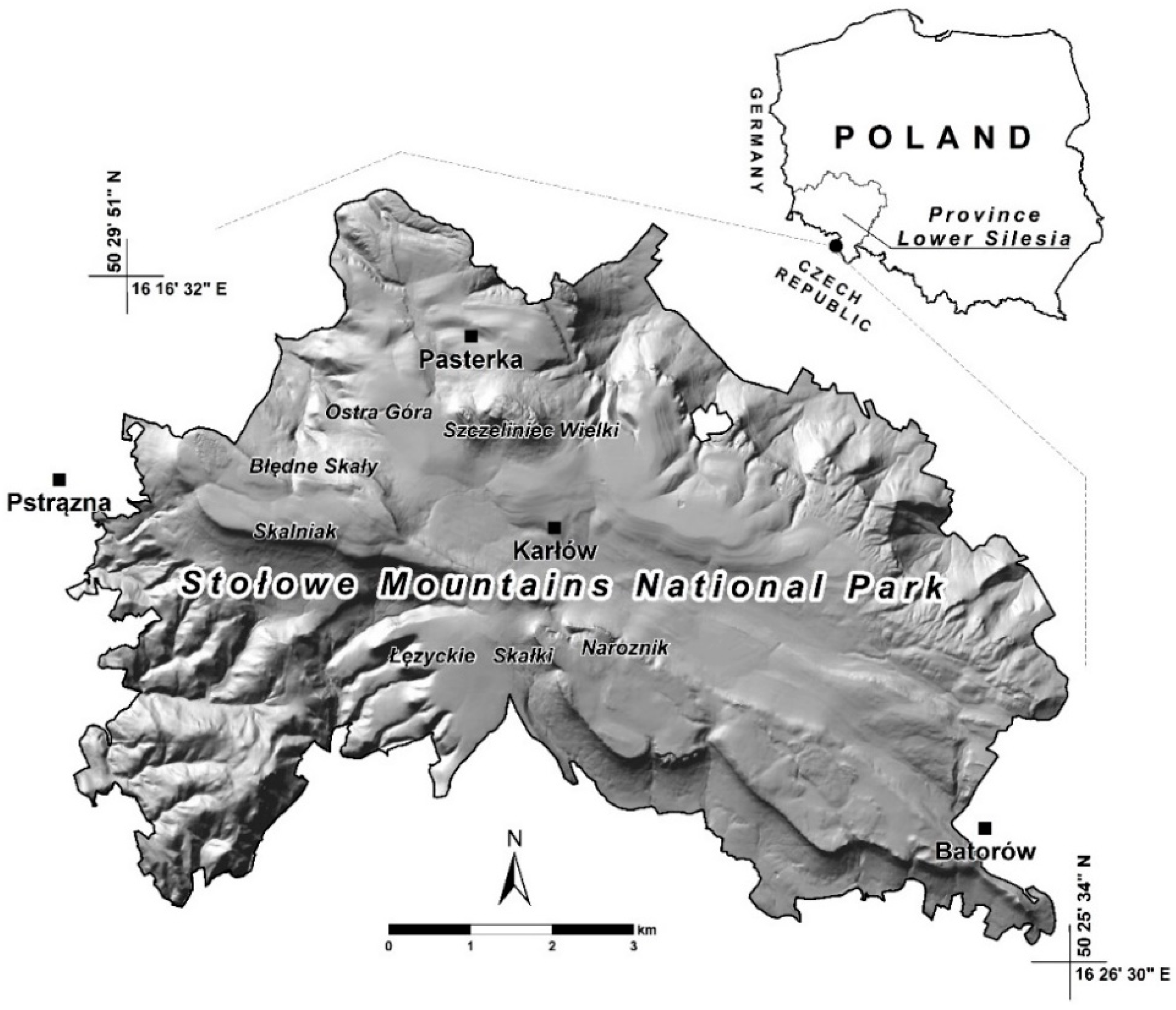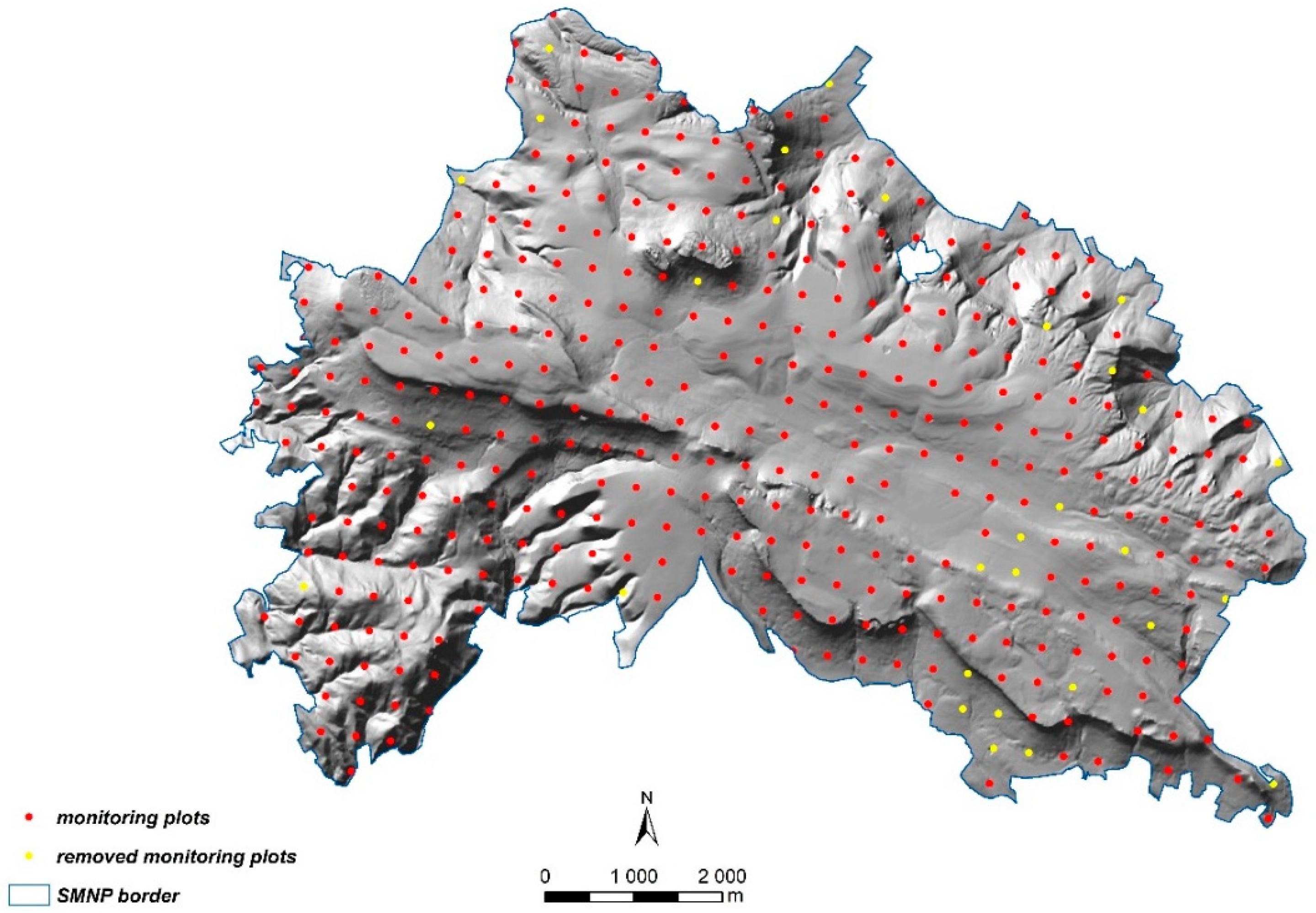Geostatistical Tools to Assess Existing Monitoring Network of Forest Soils in a Mountainous National Park
Abstract
:1. Introduction
2. Materials and Methods
2.1. Research Area
2.2. Field and Laboratory Research Methodology
2.3. Geostatistical Analyses
- 1.
- Modification of the PMNet structure by removing monitoring plots that jointly met the following conditions:
- (a)
- According to the network density analyser, they showed the lowest probability of Pb concentration > 30 mg kg−1.
- (b)
- The geostatistical analyser assigned them with the lowest weights at the estimation stage when generating a prediction map of Pb spatial distribution in the PMNet.
- 2.
- Modification of the RMNet structure by adding new monitoring plots in areas that jointly met the following conditions:
- (a)
- In the prediction of spatial distribution for PMNet, the Pb concentrations in these areas exceeded 100 mg kg−1.
- (b)
- In the geostatistical model for PMNet, the areas generated the largest errors.
- 3.
- Development of new geostatistical models for Pb concentration in the RMNet and REMNet grids and performing predictions of Pb spatial distribution for these grids. Due to time constraints, it was not possible to return to the field and perform additional analysis at new sampling points. Therefore, Pb concentrations from the PMNet prediction map were assigned to the new monitoring plots during the development of the geostatistical model for REMNet.
3. Results
3.1. Primary Monitoring Network (PMNet)
3.2. Reduced Monitoring Network (RMNet)
3.3. Reduced and Extended Monitoring Network (REMNet)
4. Discussion
5. Conclusions
Author Contributions
Funding
Institutional Review Board Statement
Informed Consent Statement
Data Availability Statement
Acknowledgments
Conflicts of Interest
Appendix A



References
- Skiba, S. Soil as a link between abiotic and biotic environment. Rocz. Bieszcz. 2017, 25, 355–372. [Google Scholar]
- Morvan, X.; Saby, N.P.A.; Arrouays, D.; Le Bas, C.; Jones, R.J.A.; Verheijen, F.G.A.; Kibblewhite, M.G. Soil monitoring in Europe: A review of existing systems and requirements for harmonization. Sci. Total Environ. 2008, 391, 1–12. [Google Scholar] [CrossRef]
- Mazurek, R.; Kowalska, J.; Gąsiorek, M.; Zadrożny, P.; Józefowska, A.; Zaleski, T.; Orłowska, K. Assessment of heavy metals contamination in surface layers of Roztocze National Park forest soils (SE Poland) by indices of pollution. Chemosphere 2017, 168, 839–850. [Google Scholar] [CrossRef] [PubMed]
- Utermann, J.; Aydın, C.T.; Bischoff, N.; Böttcher, J.; Eickenscheidt, N.; Gehrmann, J.; König, N.; Scheler, B.; Stange, F.; Wellbrock, N. Heavy metal stocks and concentrations in forest soils. In Status and Dynamics of Forests in Germany; Wellbrock, N., Bolte, A., Eds.; Ecological Studies (Analysis and Synthesis); Springer: Cham, Switzerland, 2019; Volume 237, pp. 190–229. [Google Scholar]
- Burger, J.A.; Kelting, D.L. Soil quality monitoring for assessing sustainable forest management. In The Contribution of Soil Science to the Development of and Implementation of Criteria and Indicators of Sustainable Forest Management; Adams, M.B., Ramakrishna, K., Davidson, E.A., Eds.; SSSA Special Series; Soil Science Society of America: Madison, WI, USA, 1999; Volume 53, pp. 17–52. [Google Scholar]
- Frank, J.J.; Poulakos, A.G.; Tornero-Velez, R.; Xue, J. Systematic review and meta-analyses of lead (Pb) concentrations inenvironmental media (soil, dust, water, food, and air) reported in the United States from 1996 to 2016. Sci. Total. Environ. 2019, 694, 133489. [Google Scholar] [CrossRef]
- Suchara, I.; Sucharová, J. Current atmospheric deposition loads and their trendsin the Czech Republic determined by mapping the distribution of moss element contents. J. Atmos. Chem. 2004, 49, 503–519. [Google Scholar] [CrossRef]
- Błońska, E.; Lasota, J.; Szuszkiewicz, M.; Łukasik, A.; Klamerus-Iwan, A. Assessment of forest soil contamination in Krakow surroundings in relation to the type of stand. Environ. Earth Sci. 2016, 75, 1205. [Google Scholar] [CrossRef] [Green Version]
- Kabala, C.; Karczewska, A.; Medynska-Juraszek, A. Variability and relationships between Pb, Cu, and Zn concentrations in soil solutions and forest floor leachates at heavily polluted sites. J. Plant Nutr. Soil Sci. 2014, 177, 573–584. [Google Scholar] [CrossRef]
- Gałka, B.; Kabała, C.; Łabaz, B.; Bogacz, A. Influence of stands with diversed share of Norway spruce in species structure on soils of various forest habitats in the Stołowe Mountains. Sylwan 2014, 158, 684–694. [Google Scholar]
- Lal, R. Restoring soil quality to mitigate soil degradation. Sustainability 2015, 7, 5875–5895. [Google Scholar] [CrossRef] [Green Version]
- McHale, M.R.; Lawrence, G.B.; Siemion, J.; Bonville, D.B. Establishing a national forest soil monitoring network: Chemical variability in forest soils. In Proceedings of the American Geophysical Union, Fall Meeting 2018, Washington, DC, USA, 10–14 December 2018. Abstract #H13J-1855. [Google Scholar]
- De Vries, W.; Vel, E.; Reinds, G.J. Intensive monitoring of forest ecosystems in Europe: 1. Objectives, set-up and evaluation strategy. For. Ecol. Manag. 2003, 174, 77–95. [Google Scholar] [CrossRef]
- Karczewska, A.; Szopka, K.; Bogacz, A. Zinc and lead in forest soils of Karkonosze National Park—data for assessment of environmental pollution and soil monitoring. Pol. J. Environ. Stud. 2006, 15, 336–342. [Google Scholar]
- Junxiao, W.; Xiaorui, W.; Shenglu, Z.; Shaohua, W.; Yan, Z.; Chunfeng, L. Optimization of sample points for monitoring arable land quality by simulated annealing while considering spatial variations. Int. J. Environ. Res. Public Health 2016, 13, 980. [Google Scholar]
- Szopka, K.; Karczewska, A.; Jezierski, P.; Kabala, C. Spatial distribution of lead in the surface layers of mountain forest soils, an example from the Karkonosze National Park, Poland. Geoderma 2013, 192, 259–268. [Google Scholar] [CrossRef]
- Fleck, S.; Cools, N.; De Vos, B.; Meesenburg, H.; Fischer, R. The Level II aggregated forest soil condition database links soil physicochemical and hydraulic properties with long-term observations of forest condition in Europe. Ann. Forest Sci. 2016, 73, 945–957. [Google Scholar] [CrossRef] [Green Version]
- Eid AN, M.; Olatubara, C.O.; Ewemoje, T.A.; El-Hennawy, M.T.; Farouk, H. Spatial and seasonal assessment of physico-chemical characteristics of soil in Wadi El-Rayan lakes using GIS technique. SN Appl. Sci. 2021, 3, 146. [Google Scholar] [CrossRef]
- Prietzel, J.; Falk, W.; Reger, B.; Uhl, E.; Pretzsch, H.; Zimmermann, L. Half a century of Scots pine forest ecosystem monitoring reveals long?term effects of atmospheric deposition and climate change. Glob. Chang. Biol. 2020, 26, 5796–5815. [Google Scholar] [CrossRef] [PubMed]
- Szopka, K.; Kabala, C.; Karczewska, A.; Jezierski, P.; Bogacz, A.; Waroszewski, J. The pools of soil organic carbon accumulated in the surface layers of forest soils in the Karkonosze Mountains, SW Poland. Soil Sci. Annu. 2016, 67, 46–56. [Google Scholar] [CrossRef] [Green Version]
- Rutkowski, P.; Diatta, J.; Konatowska, M.; Andrzejewska, A.; Tyburski, Ł.; Przybylski, P. Geochemical referencing of natural forest contamination in Poland. Forests 2020, 11, 157. [Google Scholar] [CrossRef] [Green Version]
- Lu, Z. Construction of soil environment information management platform based on ArcGIS. IOP Conf. Ser. Earth Environ. Sci. 2020, 546, 032039. [Google Scholar]
- Łyszczarz, S.; Błońska, E.; Lasota, J. The application of the geo-accumulation index and geostatistical methods to the assessment of forest soil contamination with heavy metals in the Babia Góra National Park (Poland). Arch. Environ. Prot. 2020, 46, 69–79. [Google Scholar]
- Obade, V.; Lal, R. Assessing land cover and soil quality by remote sensing and geographical information systems (GIS). Catena 2013, 104, 77–92. [Google Scholar] [CrossRef]
- Moore, F.; Sheykhi, V.; Salari, M.; Bagheri, A. Soil quality assessment using GIS-based chemometric approach and pollution indices: Nakhlak mining district, Central Iran. Environ. Monit. Assess. 2016, 188, 214. [Google Scholar] [CrossRef]
- Zhu, X. GIS for Environmental Applications: A Practical Approach; Routledge: Abingdon, NY, USA, 2016; p. 471. [Google Scholar]
- O’Riordan, T. Environmental Science for Environmental Management, 2nd ed.; Taylor & Francis: Germantown, NY, USA, 2000; p. 519. [Google Scholar]
- Wright, D.J.; Harder, C. GIS for Science: Applying Mapping and Spatial Analytics; ESRI Press: Redlands, CA, USA, 2019; p. 252. [Google Scholar]
- Hernandez-Stefanoni, J.L.; Ponce-Hernandez, R. Mapping the spatial variability of plant diversity in a tropical forest: Comparison of spatial interpolation methods. Environ. Monit. Assess. 2006, 117, 307–334. [Google Scholar] [CrossRef] [PubMed]
- Kimsey, M.J.; Laing, L.E.; Anderson, S.M.; Bruggink, J.; Campbell, S.; Diamond, D.; Vaughan, R. Soil Mapping, Monitoring, and Assessment. In Forest and Rangeland Soils of the United States Under Changing Conditions; Springer: Cham, Switzerland, 2020; pp. 169–188. [Google Scholar]
- Trofymchuk, O.; Klymenko, V.; Anpilova, Y.; Sheviakina, N.; Zagorodnia, S. The aspects of using GIS in monitoring of environmental components. In Proceedings of the International Multidisciplinary Scientific GeoConference: SGEM, Albena, Bulgaria, 16–25 August 2020; Volume 20, pp. 581–588. [Google Scholar]
- Karczewska, A.; Bogacz, A.; Kabała, C.; Szopka, K.; Duszyńska, D. Methodology of soil monitoring in a forested zone of the Karkonosze National Park with reference to the diversity of soil properties. Polish J. Soil Sci. 2006, XXXIX/2, 117–129. [Google Scholar]
- Wawrzoniak, J. (Ed.) The Health Status of Forests in Poland in 2018; Forest Research Institute, Department of Forest Resources Management: Sękocin Stary, Poland, 2019; p. 66. [Google Scholar]
- Bojko, O.; Kabala, C. Transformation of physicochemical soil properties along a mountain slope due to land management and climate changes-a case study from the Karkonosze Mountains, SW Poland. Catena 2016, 140, 43–54. [Google Scholar] [CrossRef]
- Szopka, K.; Karczewska, A.; Kabala, C. Mercury accumulation in the surface layers of mountain soils: A case study from the Karkonosze Mountains, Poland. Chemosphere 2011, 83, 1507–1512. [Google Scholar] [CrossRef] [PubMed]
- Raj, A.; Zientarski, J. Monitoring of forest ecosystems in the Karkonosze National Park. Opera Corcon. 2007, 44, 423. [Google Scholar]
- Pennock, D.J. Designing field studies in soil science. Can. J. Soil Sci. 2004, 84, 1–10. [Google Scholar] [CrossRef] [Green Version]
- O’Harea, M.T.; Gunna, I.D.M.; Critchlow-Wattonb, N.; Guthrieb, R.; Taylorb, C.; Chapmana, D.S. Fewer sites but better data? Optimising the representativeness and statistical power of a national monitoring network. Ecol. Indic. 2020, 114, 106321. [Google Scholar]
- De Gruijter, J.; Brus, D.; Bierkens, M.; Knotters, M. Sampling for Natural Resource Monitoring; Springer: Berlin/Heidelberg, Germany; New York, NY, USA, 2006; p. 326. [Google Scholar]
- Sampling Design Part 1—Application. Contaminated Land Guidelines; State of New South Wales and the NSW Environment Protection Authority, NSW EPA: Parramatta, Australia, 2020; p. 84.
- Nordgaard, A.; Correll, R. Sampling Strategies. In Integrated Analytical Approaches for Pesticide Management; Maestroni, B., Cannavan, A., Eds.; Academic Press Elsevier: Cambridge, MA, USA, 2018; pp. 31–46. [Google Scholar]
- Black, H.; Bellamy, P.; Creamer, R.; Elston, D.; Emmett, B.; Frogbrook, Z.; Hudson, G.; Jordan, C.; Lark, M.; Lilly, A.; et al. Design and Operation of a UK Soil Monitoring Network; Science Report—SC060073; Environment Agency: Bristol, UK, 2008; p. 218. [Google Scholar]
- Lindenmayer, D.B.; Likens, G.E. Adaptive monitoring: A new paradigmfor long term research and monitoring. Trends Ecol. Evol. 2009, 24, 482–486. [Google Scholar] [CrossRef]
- Yanguo, T.; Jin, W.; Sijin, L.; Yeyao, W.; Xudong, J.; Liuting, S. Soil and soil environmental quality monitoring in China: A review. Environ. Int. 2014, 69, 177–199. [Google Scholar]
- Xiao-Ni, H.; Hong, L.; Dan-Feng, S.; Lian-Di, Z.; Bao-Guo, L. Combining geostatistics with Moran’s I analysis for mapping soil heavy metals in Beijing, China. Int. J. Environ. Res. Public Health 2012, 9, 995–1017. [Google Scholar]
- Arrouays, D.; Marchant, B.P.; Saby, N.P.A.; Meersmans, J.; Orton, T.G.; Martin, M.P.; Bellamy, P.H.; Lark, R.M.; Kibblewhite, M. Generic Issues on Broad-Scale Soil Monitoring Schemes: A Review. Pedosphere 2012, 22, 456469. [Google Scholar] [CrossRef]
- Hofman, C.K.; Brus, D.J. How many sampling points are needed to estimate the mean nitrate-N content of agricultural fields? A geostatistical simulation approach with uncertain variograms. Geoderma 2021, 385, 114816. [Google Scholar] [CrossRef]
- Guo, L.; Linderman, M.; Shi, T.; Chen, Y.; Duan, L.; Zhang, H. Exploring the sensitivity of sampling density in digital mapping of soil organic carbon and its application in soil sampling. Remote Sens. 2018, 10, 888. [Google Scholar] [CrossRef] [Green Version]
- Migoń, P.; Latocha, A.; Parzóch, K.; Kasprzak, M. Contemporary geomorphic system of the Stolowe Mountains. In Geo-Ecological Conditions of the Stolowe Mountains National Park; Chodak, T., Ed.; Wind: Wroclaw, Poland, 2011; pp. 1–52. [Google Scholar]
- Wojewoda, J. Geological structure of the PNGS area. In Nature of the Stołowe Mountains National Park; Witkowski, A., Pokryszko, P.M., Ciężkowski, W., Eds.; PNGS Publishing: Kudowa Zdrój, Poland, 2008; p. 404. [Google Scholar]
- Pawlak, W. Atlas of Lower and Opole Silesia, 2nd ed.; Wroclaw University: Wroclaw, Poland, 2008. [Google Scholar]
- Kabała, C.; Chodak, T.; Bogacz, A.; Łabaz, B.; Jezierski, P.; Gałka, B.; Kaszubkiewicz, J.; Glina, B. Spatial variability of soils and habitats in the Stołowe Mountains National Park. In Geoecological Conditions of the Stołowe Mountains National Park Natural Environment; Chodak, T., Kabała, C., Kaszubkiewicz, J., Migoń, P., Wojewoda, J., Eds.; WIND Publishing: Wrocław, Poland, 2011; pp. 141–168. [Google Scholar]
- Jędryszczak, E.; Miścicki, S. Lasy Parku Narodowego Gór Stołowych. Szceliniec 2001, 4, 79–103. [Google Scholar]
- Świerkosz, K.; Boratyński, A. Chorological and synanthropodynamical analysis of trees and shrubs of the Stołowe Mts. (Middle Sudety). Dendrobiology 2002, 48, 75–85. [Google Scholar]
- Labaz, B.; Galka, B.; Bogacz, A. Factors influencing humus forms and forest litter properties in the mid-mountains under temperate climate of southwestern Poland. Geoderma 2014, 230, 265–273. [Google Scholar] [CrossRef]
- National Geoportal. Available online: https://mapy.geoportal.gov.pl/imap/Imgp_2.html?locale=pl&gui=new&sessionID=4943882 (accessed on 19 January 2021).
- Miścicki, S.; Nowicka, E. Measurement of forest resources using permanent concentric sample plots—Problems and attempts at their solving. Sylwan 2007, 151, 15–26. [Google Scholar]
- Regulation of the Ministry of Environment (Poland) on the Method of Assessing the Pollution of the Land Surface. Available online: http://isap.sejm.gov.pl/isap.nsf/DocDetails.xsp?id=WDU20160001395 (accessed on 13 January 2021).
- Isaaks, E.H.; Srivastava, R.M. An Introduction to Applied Geostatistics; Oxford University Press: New York, NY, USA, 1989; p. 398. [Google Scholar]
- Kabata-Pendias, A.; Pendias, H. Pierwiastki Śladowe w Glebie i Roślinach; CRC Press: Boca Raton, FL, USA, 2011; p. 365. [Google Scholar]
- El-Sayed, E.O. Improving the prediction auccuracy of oil mapping through geostatistics. Int. J. Geosci. 2012, 3, 574–590. [Google Scholar]
- Wu, W.; Xie, D.T.; Liu, H.B. Spatial variability of soil heavy metals in the three gorges area: Multivariate and geostatistical analyses. Environ. Monit Assess. 2009, 157, 63–71. [Google Scholar] [CrossRef] [PubMed]
- Kerry, R.; Oliver, K.O. Determining nugget:sill ratios of standardized variograms from aerial photographs to krige sparse soil data. Precis. Agric. 2008, 9, 33–56. [Google Scholar] [CrossRef]
- Fischer, M.M.; Getis, A. (Eds.) Handbook of Applied Spatial Analysis: Software Tools, Methods and Applications; Springer: Berlin, Germany, 2010; pp. 125–134. [Google Scholar]
- Flatman, G.T.; Yfantis, A.A. Geostatistical strategy for soil sampling: The survey and the census. Environ. Monit. Assess. 1984, 4, 335–349. [Google Scholar] [CrossRef]
- Hu, B.; Zhou, Y.; Jiang, Y.; Ji, W.; Fu, Z.; Shao, S.; Li, S.; Huang, M.; Zhou, L.; Shi, Z. Spatio-temporal variation and source changes of potentially toxic elements in soil on a typical plain of the Yangtze River Delta, China (2002–2012). J. Environ. Manag. 2020, 271, 110943. [Google Scholar] [CrossRef] [PubMed]
- Van Groenigen, J.W.; Siderius, W.; Stein, A. Constrained optimisation of soil sampling for minimisation of the kriging variance. Geoderma 1999, 87, 239–259. [Google Scholar] [CrossRef]
- Webster, R.; Olivier, M.A. Geostatistics for Environmental Scientists, 2nd ed.; John Wiley & Sons Ltd.: Chichester, UK, 2007; p. 317. [Google Scholar]
- Krivoruchko, K. Spatial Statistical Data Analysis for GIS Users; Esri Press: Redlands, CA, USA, 2011; p. 928. [Google Scholar]
- Mmcbratney, A.B.; Webster, R. Choosing functions for semi-variograms of soil properties and fitting them to sampling estimates. J. Soil Sci. 1986, 37, 617–639. [Google Scholar] [CrossRef]
- Mmcbratney, A.B.; Webster, R.; Burgess, T.M. The design of optimal sampling schemes for local estimation and mapping of regionalized variables—I. Comput. Geotcitnces 1981, 7, 331–334. [Google Scholar]







| N | Minimum | Maximum | Mean | Median | Standard Deviation |
|---|---|---|---|---|---|
| mg kg−1 | |||||
| 387 * | 3.5 | 219 | 46.6 | 41.0 | 28.6 |
| Monitoring Network | Model * | Number of Samples | Nugget | Partial Sill | Range, m | RNS |
|---|---|---|---|---|---|---|
| (C0) | (C0 + C) | (A0) | C0/(C0 + C) | |||
| PMNet | stable | 387 | 0.101 | 0.182 | 1002 | 0.36 |
| RMNet | stable | 357 | 0.301 | 0.621 | 1162 | 0.33 |
| REMNet | gaussian | 377 | 0.362 | 0.510 | 1130 | 0.42 |
| Monitoring Network | MSE | RMSE |
|---|---|---|
| Mean Standardized Error | Root Mean Squared Error | |
| PMNet | −0.014 | 1.009 |
| RMNet | −0.025 | 1.000 |
| REMNet | 0.023 | 1.011 |
Publisher’s Note: MDPI stays neutral with regard to jurisdictional claims in published maps and institutional affiliations. |
© 2021 by the authors. Licensee MDPI, Basel, Switzerland. This article is an open access article distributed under the terms and conditions of the Creative Commons Attribution (CC BY) license (http://creativecommons.org/licenses/by/4.0/).
Share and Cite
Jezierski, P.; Kabala, C. Geostatistical Tools to Assess Existing Monitoring Network of Forest Soils in a Mountainous National Park. Forests 2021, 12, 333. https://doi.org/10.3390/f12030333
Jezierski P, Kabala C. Geostatistical Tools to Assess Existing Monitoring Network of Forest Soils in a Mountainous National Park. Forests. 2021; 12(3):333. https://doi.org/10.3390/f12030333
Chicago/Turabian StyleJezierski, Pawel, and Cezary Kabala. 2021. "Geostatistical Tools to Assess Existing Monitoring Network of Forest Soils in a Mountainous National Park" Forests 12, no. 3: 333. https://doi.org/10.3390/f12030333






